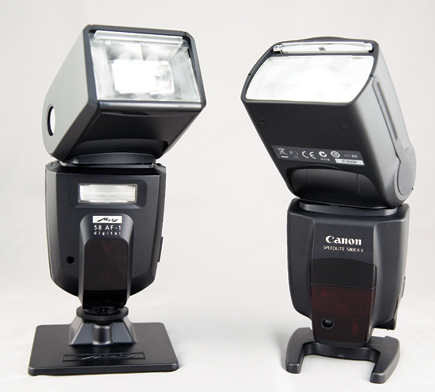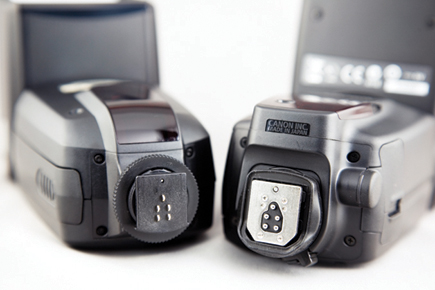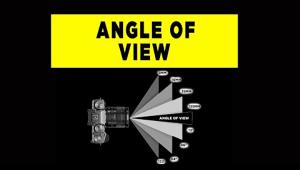Canon’s Speedlite 580EX II & Metz’s Mecablitz 58 AF-1C Digital;
I've been a long-time proponent of Canon Speedlites, and also an avid follower of Metz flashes. I always liked the Metz for its sturdy quality and reliability--I'd owned a Metz potato masher (handlemount, in the old vernacular). But when I switched to the Canon EOS system, I became a devout Canon shoe-mount advocate, finding these flashes dependable and robust. I watched Canon Speedlites evolve over the years, to the point where it seemed to make no sense to use anything else. When the 580EX came along, I immediately bought one to supplant my 550EX as my main flash. (I also keep the smaller, less-powerful 430EX around for less-demanding tasks, and because it's handy for multi-flash setups.) Then the Metz unit appeared on the scene, and I was tempted. But before I had a chance to act, Canon revamped the 580EX and came up with the 580EX II. With this flash, Canon finally had a shoe mount with an auto-thyristor control option as an alternative to E-TTL/E-TTL II (Canon calls it "external metering"--and there's a catch to the way it works). So, should I scrap my 580EX and replace it with the newer 580EX II, or switch to the Metz 58 AF-1C? After all, the two shoe mounts have much in common. Not an easy choice. (I should add that there is a Nikon compatible Metz 58 AF-1N. You can get more information at Bogen's website, or at www.metz.de/en.)
 |
|
 |
|
 |
|
|
The Good And The Quirky
Simply stated, practically anything you could ever want in a shoe-mount strobe
is found in these two flash units. They both offer E-TTL II, E-TTL, and TTL
control with compatible Canon EOS cameras (standard TTL is less reliable); flash
exposure compensation and auto flash bracketing (remember: settings on the flash
override those made on the camera); high-speed sync; flash coverage that corresponds
to image sensor size; swivel and tilt (including macro tilt); stroboscopic flash;
modeling flash; and wireless remote operation, to name some of the more salient
features. However, there are some differences in the way each flash unit can
be set up to deliver a few of these features or in the scope of these functions
(see Table below).
| Canon's Speedlite 580EX II Vs. Metz's
Mecablitz 58 AF-1C Choosing between these two flash units is not easy. Hopefully this table will help in the decision-making process. (Note 1: E-TTL and E-TTL II may not be available when either flash is used with older EOS models. Note 2: On the Metz unit, certain functions, such as E-TTL and high-speed sync, become available--and the settings visible on the display panel--only when the flash is connected to the camera and the camera is turned on.) |
||
| Feature/Model |
Canon 580EX II |
Metz 58 AF-1C |
| GN (in feet at ISO 100, max. zoom) | 190 | 192 |
| Flash Coverage | 24-105mm (auto + manual zoom); 14mm with wide panel | 24-105mm (auto + manual zoom); 18mm with wide panel |
| E-TTL II, E-TTL, TTL Flash Control | Yes | Yes (camera may need to be connected/on for certain functions to be displayed) |
| Auto-Thyristor Control | Yes (activated via CFn button) | Yes (activated via Mode button) |
| Manual Flash Control | Yes (with ratio control to 1/128) | Yes (with ratio control to 1/256) |
| Flash Exposure Compensation/Bracketing | Yes (to +/- 3 stops) | Yes (to +/- 3 stops) |
| Color Temperature | Controlled through compatible camera | 5600K |
| Flash Coverage Matches Image Sensor Size |
Yes | Yes |
| Secondary Reflector | No | Yes (activated via Select button--with bounce flash) |
| Bounce Panel | Yes | Yes |
| Swivel & Tilt | Yes (-7 macro tilt to +90Þ bounce tilt; 360Þ swivel | Yes (-7 macro tilt to +90Þ bounce tilt; 270Þ swivel) |
| High-Speed Sync/2nd-Curtain Sync/ Stroboscopic Flash/Modeling Flash | Yes (via various buttons) | Yes (via various buttons--camera may need to be connected/on for certain functions to be displayed) |
| Wireless Control | Yes (activated by holding down Zoom button) | Yes (activated via Select button) |
| Custom Functions (to control various operating parameters) | 14 (available via CFn button) | Limited and not actually referred to as custom functions (available via Select button) |
| Backlit Digital LCD | Yes (manually activated) | Yes (automatically activated) |
| Hot Shoe/Locking Mechanism | Metal/lever with release | Plastic/thumbwheel |
| USB Firmware Updates | Not applicable | Yes (via USB terminal on flash--but without any actual firmware updates to date, this is a questionable benefit) |
| PC Socket (for conventional sync cord connection) | Yes | No |
| Water- & Dust-Resistant | Yes | No |
| On/Off Switch | Two-position lever | Two-position switch |
| Battery Compartment | Adds locking latch | Conventional |
| Size | 3x5.4x4.6" | 2.8x5.9x4" |
| Weight | 14.3 oz | 12.4 oz |
| Price (online retailer) | $430 | $375 |
| Pros | Simple interface makes it easy to access basic functions; weather/dust-resistant; automatically reverts to Normal Sync mode when seated in camera hot shoe even if previously set to Slave Sync mode; wide wireless sensor acceptance angle. | Secondary flash head is really handy for fill flash when using bounce lighting (although it can cast a shadow on a nearby background); setting wireless flash is simpler on this unit; display automatically lights when any button is pressed--I love this feature! |
| Cons | You may have to hunt down the more esoteric functions, such as wireless flash; display annoyingly blinks when flash head is tilted upward or swiveled--head has to be reset to basic position when making settings. | Complex menu tree and interface: buttons are not clearly identified so you're never sure which button does what; manual is too big to carry conveniently and not user-friendly; needs a direct line of sight for wireless slave-sync. |

































